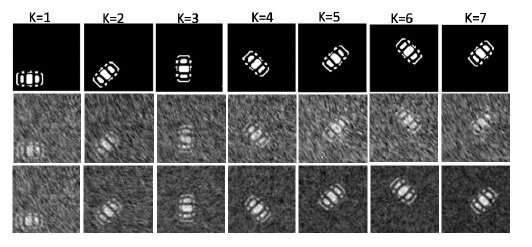Researchers capture moving object with ghost imaging

Researchers have developed a way to capture moving objects with the unconventional imaging method known as ghost imaging. The new method could make the imaging technique practical for new applications such as biomedical imaging, security checks and video compression and storage.
Ghost imaging comes with a host of advantages, one of which is that it allows one to form an image by illuminating the object with lower light levels than traditional imaging approaches. However, ghost imaging has been limited to stationary objects because it takes a long time to project the sequence of light patterns onto the object that is necessary to reconstruct an image. This causes images of a moving object to appear blurry.
In The Optical Society (OSA) journal Optics Letters, researchers from the National University of Defense Technology in China describe how they were able to combine information in the blurry images with details about the object's location to create high quality images of moving objects with ghost imaging.
"Our work shows that blurred images contain useful information," said research team leader Wei-Tao Liu. "With further improvements, this approach could make ghost imaging useful for applications such as biomedical imaging of human beings. If used with x-rays, for example, it could help reduce the radiation dose needed for imaging."
Creating a clear image
The ghost imaging technique forms an image by correlating a beam that interacts with the object and a reference beam that does not. Individually, the beams don't carry any meaningful information about the object. The imaging technique works with visible light, x-rays and other parts of the electromagnetic spectrum and, when the structured light beams are generated computationally with spatial light modulators, can be performed with a low-cost single-pixel detector instead of a complex, expensive camera.
To apply ghost imaging to moving objects, the new method uses a small number of light patterns to capture the position and trajectory of the object. The researchers developed an algorithm to cross correlate this positional information with blurred images captured at different positions, allowing a clear image to be gradually formed.
"This approach relaxes the requirement for fast imaging, and because the algorithm is linear, it doesn't require a large amount of computing power," explained Liu. "The method can be performed with a typical ghost imaging system without any additional devices and allows the image to be reconstructed in a timely manner."
Standard setup captures new information
The researchers demonstrated their new method using a typical ghost imaging system, in which a random light field generated by a rotating diffuser was divided into two beams. One beam was recorded by a CCD camera, while the other illuminated a moving object the researchers created using a digital micromirror device. The light coming from the moving object was collected by a single-pixel detector.
"We demonstrated that our method captured the trajectory of the image and formed a high-quality image," said Liu. "With these same experimental conditions, traditional ghost imaging approaches would have lost most of the object information due to blurring from movement."
More information: Shuai Sun et al, Gradual ghost imaging of moving objects by tracking based on cross correlation, Optics Letters (2019). DOI: 10.1364/OL.44.005594
Journal information: Optics Letters
Provided by The Optical Society



















